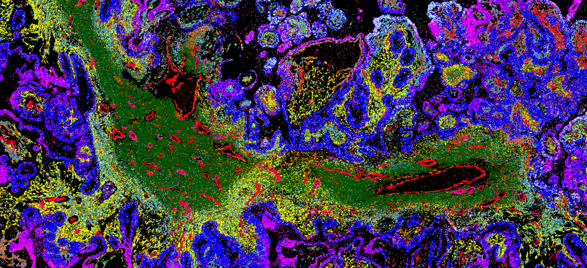Spatial transcriptomics is transforming how scientists study the molecular foundations of health and disease by combining the strengths of single-cell RNA sequencing (scRNA-seq) and traditional RNA fluorescence in situ hybridization (RNA FISH). While scRNA-seq offers transcriptome-wide insights without spatial context, and RNA FISH provides precise localization but with limited multiplexing, spatial transcriptomics brings the best of both worlds, allowing researchers to visualize where thousands of genes are expressed within intact tissues. This spatial information helps uncover how cells are organized, how they interact, and how local tissue environments influence function, offering a more complete picture of biological processes and disease mechanisms.
This technology is opening up new possibilities across cancer research, infectious disease, chronic conditions, and personalized medicine. As spatial transcriptomics becomes more widely adopted, it is being used not only in academic labs but also in applied discovery pipelines across biopharma and diagnostics. For example, researchers have used spatial transcriptomics to study immune cell infiltration in breast cancer tumors, map tissue injury patterns in COVID-19 lungs, and localize inflammation signatures in Alzheimer’s disease models. Several life science companies have also integrated spatial profiling into their research programs, with platforms like Vizgen’s MERSCOPE Ultra Platform enabling high-plex, single-cell resolution studies on FFPE and fresh-frozen samples.
These real-world applications are accelerating our understanding of disease mechanisms and helping bridge the gap between exploratory research and clinical insight.
Mapping the Tumor Microenvironment in Cancer
One of the most promising areas for spatial transcriptomics is cancer research. Tumors contain more than just cancer cells. They include immune cells, fibroblasts, blood vessels, and other components that form the tumor microenvironment. The relationships between these cells and tissues are often what drive a tumor’s growth or resistance to treatment.
With spatial transcriptomics, researchers can examine how different cell types are arranged within a tumor and how they interact. In studies of breast cancer and melanoma, for example, scientists used spatial transcriptomics to uncover patterns of immune cell infiltration and fibroblast activity that correlate with patient outcomes. These insights are helping to identify new therapeutic targets and guide the design of more effective treatments.
Revealing Tissue-Level Impacts of Infectious Disease
Spatial transcriptomics has also helped researchers understand how infections affect tissues at the cellular level. During the COVID-19 pandemic, scientists used this technology to analyze lung tissue from patients. They found distinct patterns of inflammation, tissue damage, and viral RNA across different cell types.
These findings helped clarify why the disease was so severe in some people and milder in others. They also provided new information about how the immune system responds to the virus across different parts of the lung. This kind of information is also valuable for studying other infections like HIV or tuberculosis, where the immune response varies depending on tissue context.
Decoding Complex Chronic Diseases
Chronic diseases can be incredibly difficult to study because the changes they cause are often subtle and distributed across tissues. Spatial transcriptomics offers a clearer picture of how these diseases unfold.
- In diabetes research, for example, spatial transcriptomics has been used to study the pancreas. Researchers have identified gene expression patterns linked to stressed or failing beta cells, which are responsible for producing insulin.
- In the brain, this technology has helped map how inflammation and protein buildup vary across regions affected by Alzheimer’s disease.
- Similarly, cardiovascular researchers are using spatial transcriptomics to map gene expression across regions of the heart and vasculature, revealing how immune cells, fibroblasts, and endothelial cells interact within atherosclerotic plaques and contribute to localized inflammation and plaque instability in the vessel wall .
These discoveries are helping researchers pinpoint early warning signs and develop more targeted interventions.
Enabling Personalized Medicine
No two patients are exactly the same, and personalized medicine aims to reflect that. Spatial transcriptomics plays an important role here by uncovering the unique molecular fingerprints of disease in individual patients.
Take cancer again as an example. Even if two patients have the same tumor type, the internal makeup of those tumors can vary significantly. Spatial transcriptomics can help identify which regions of a tumor are likely to respond to therapy and which might resist it. That kind of information can be used to guide treatment decisions and tailor care more effectively.
Beyond cancer, spatial profiling is starting to inform treatment choices for autoimmune and inflammatory conditions by revealing patient-specific gene expression patterns.
Future Applications and Challenges
Looking ahead, spatial transcriptomics is emerging as a richer, more versatile data source for understanding tissue biology. Researchers are already combining it with other modalities, such as spatial proteomics and advanced imaging, to build more complete views of tissue biology. Machine learning tools are also helping researchers manage and interpret the large volumes of data that these technologies generate.
There are still challenges to address. Wider adoption in clinical and translational settings will depend on more standardized workflows, easier-to-use analysis tools, and scalable infrastructure for managing and sharing complex datasets. Progress is being made on these fronts. New platforms, like Vizgen’s MERSCOPE Ultra, are designed to improve accessibility by increasing throughput, supporting FFPE samples, and enabling more flexible panel design. These advances reduce barriers for researchers and expand the reach of spatial transcriptomics across different types of studies.
As the technology continues to evolve, its potential to reshape how we study and treat human disease is becoming increasingly clear. Linking gene activity to spatial context is providing insights that were previously out of reach, opening new possibilities for discovery, diagnosis, and care.

See Spatial Transcriptomics in Action
Gain access to high-quality spatial transcriptomics datasets with Vizgen’s Data Release Program. Explore real-world applications, benchmark performance, and uncover new biological insights. See how spatially resolved gene expression data can drive discoveries in oncology, neuroscience, and beyond.